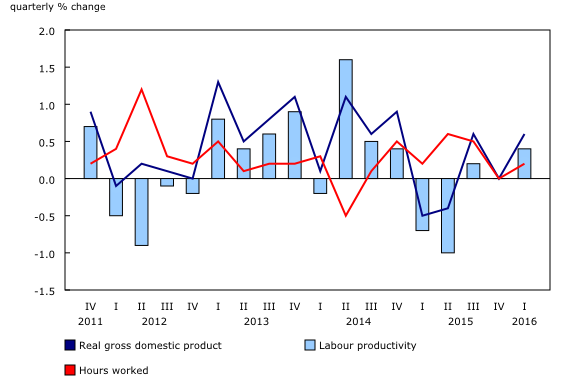Labour productivity, hourly compensation and unit labour cost, first quarter 2016
Archived Content
Information identified as archived is provided for reference, research or recordkeeping purposes. It is not subject to the Government of Canada Web Standards and has not been altered or updated since it was archived. Please "contact us" to request a format other than those available.
Released: 2016-06-03
First quarter 2016
0.4% 
(quarterly change)
Labour productivity rises
Labour productivity of Canadian businesses rose 0.4% in the first quarter, following no growth in the fourth quarter. This was the largest increase since the fourth quarter of 2014.
The productivity gain in the first quarter accounted for two-thirds of the output growth of businesses, while growth in hours worked accounted for the remaining third. Output and hours worked were essentially flat in the fourth quarter.
Real gross domestic product (GDP) of businesses increased 0.6% in the first quarter, after a flat fourth quarter. In the first quarter, output of service-producing businesses (+0.6%) increased at a rate similar to the previous three quarters, while output of goods-producing businesses (+0.2%) resumed growth after a decline in the fourth quarter.
Hours worked in the business sector increased 0.2% in the first quarter, and were virtually unchanged in the previous quarter. Hours worked in goods-producing businesses rose 0.5% in the first quarter, while hours worked in service-producing businesses edged up 0.1%. Utilities, arts, entertainment and recreation, and construction posted the highest gains.
Productivity gains in the business sector in the first quarter were attributable to service-producing businesses (+0.5%). Transportation and warehousing (+2.7%), retail trade (+1.1%), and finance and insurance (+1.1%) were the largest contributors to the gain.
Goods-producing businesses posted a 0.3% decrease in productivity in the first quarter, mainly as a result of sharp decreases in construction (-2.7%) and utilities (-2.5%). However, productivity was up in mining, quarrying, and oil and gas extraction (+3.8%) and manufacturing (+1.0%).
In the United States, the labour productivity of businesses fell 0.3% in the first quarter, after decreasing 0.5% in the previous quarter. This was the second time in six quarters that US productivity declined for two consecutive quarters. In the first quarter, real GDP of American businesses edged up 0.1%, after advancing 0.4% in the previous quarter. Hours worked (+0.4%) continued to increase, but at half the pace of the previous quarter.
Unit labour costs decline
For Canadian businesses, productivity growth (+0.4%) was greater than growth in average compensation per hour worked (+0.1%) in the first quarter. Consequently, labour cost per unit of output in Canadian businesses was down 0.3% in the first quarter, after a 0.9% increase the previous quarter.
The gain in hourly compensation in service-producing businesses (+0.5%) more than offset the decrease in hourly compensation in goods-producing businesses (-0.8%). Construction, manufacturing and utilities were the main sectors posting declines in the first quarter.
In US dollars, the unit labour costs of Canadian businesses declined 3.2% in the first quarter, down for a third straight quarter. Most of these declines were due to the depreciation of the average value of the Canadian dollar relative to the US dollar over the same period. In the first quarter, the Canadian dollar fell 2.9%, following declines in the third quarter (-6.0%) and fourth quarter (-2.0%) of 2015.
By comparison, the unit labour costs of American businesses rose 1.0%, after increasing 0.6% in the previous quarter.
Note to readers
Revisions
With this release on labour productivity and related measures, data were revised back to the first quarter of 1981 at the aggregate and industry levels.
As well, labour productivity indexes and related variables underwent a historical revision from the first quarter of 1981 to the fourth quarter of 2015, as a result of revisions to the values for the 2007 reference year. However, the resulting growth rate revisions were negligible.
These revisions are consistent with those incorporated in the quarterly gross domestic product (GDP) based on earnings and expenditures, and in the monthly GDP by industry, published on December 1, 2015, and May 31, 2016.
This release also takes into account the annual benchmarks for labour productivity data and their related variables in the business sector by industry at the provincial and territorial level, published on May 2, 2016.
Productivity measure
The term productivity in this release refers to labour productivity. For the purposes of this analysis, labour productivity and related variables cover the business sector only.
Labour productivity is a measure of real GDP per hour worked.
Unit labour cost is defined as the cost of workers' wages and benefits per unit of real GDP.
All the growth rates reported in this release are rounded to one decimal place. They are calculated with index numbers rounded to three decimal places, which are now available on CANSIM.
All necessary basic variables for productivity analyses (such as hours worked, employment, output and compensation) are seasonally adjusted. For information on seasonal adjustment, see Seasonally adjusted data – Frequently asked questions.
Next release
Labour productivity, hourly compensation and unit labour cost data for the second quarter will be released on September 2.
Products
The System of Macroeconomic Accounts module, accessible from the Browse by key resource module of our website, features an up-to-date portrait of national and provincial economies and their structure.
The Methodological Guide: Canadian System of Macroeconomic Accounts (13-607-X) is available from the Browse by key resource module of our website, under Publications.
The User Guide: Canadian System of Macroeconomic Accounts (13-606-G) is also available from the Browse by key resource module of our website, under Publications. This publication will be updated to maintain its relevance.
Contact information
For more information, or to enquire about the concepts, methods or data quality of this release, contact us (toll-free 1-800-263-1136; 514-283-8300; STATCAN.infostats-infostats.STATCAN@canada.ca) or Media Relations (613-951-4636); STATCAN.mediahotline-ligneinfomedias.STATCAN@canada.ca).
- Date modified:


